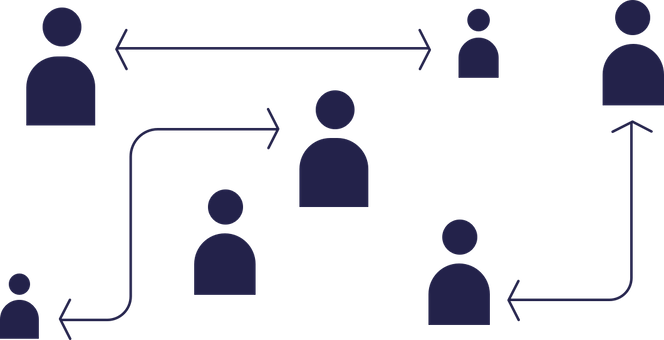
Agent-based modelling (ABM)
Agent-based modelling (ABM) is a powerful technique for simulating complex systems with a high degree of accuracy and realism. It enables us to represent a wide range of complex systems, such as financial markets, societies, and infrastructure networks, in det Agent-based modeling (ABM) is a method for simulating complex systems. These systems can include financial markets, societies, infrastructure networks, or organisations, which can be represented in detail and simulated realistically using ABM, providing a reliable simulation of these complex systems and phenomena in the face of often unpredictable events within these systems.
ABM typically involves three key components: agents, their environment, and the rules that govern their behaviour. Unlike other modelling approaches, ABM allows for the emergence of macro-level behaviour through the interactions of agents at the micro-level. This makes ABM particularly useful for exploring complex and unpredictable systems that are subject to change.
The strength of ABM lies in its ability to meaningfully examine the behaviour of complex systems. Through the interactions of agents and the changes in their environment, ABM can simulate the heterogeneous phenomena and unpredictable changes that occur within these systems, resulting in accurate and meaningful forecasts.
How does agent-based modeling (ABM) work?
In ABM, each agent is programmed to make decisions based on pre-defined rules, leading to the emergence of new patterns and interactions that may not have been apparent when considering individual agents in isolation. This allows for accurate modelling and exploration of the links between micro-level and macro-level phenomena, setting ABM apart from other modelling techniques.
Unlike other types of modeling, ABM involves many different agents or units with decision-making and action-taking capabilities. Agent-based modeling enables the modeling or investigation of connections between micro and macro levels precisely.
Agents
In agent-based modelling, the behaviour of agents as entities at the centre plays a major role. But how can these agents actually be defined?
Agents are the central entities in agent-based modelling and define the behaviour of the system being simulated. These software-based agents can have internal states, such as age and gender, and employ decision-making processes that can be handled by many agents simultaneously. This allows large populations of heterogeneous agents to be created and observed, providing insights into the interactive processes between them. Agents can be diverse in terms of individual characteristics, such as gender, education, attitudes and values, and simulation models typically work with explicit agent types that have common combinations of these characteristics.
Rules
Rules play a critical role in the behaviour of agents, influencing the decisions they make, how information is obtained and disseminated, and the degree of rationality behind their actions. Individual agents may have different individual networks, within which they exchange information and position themselves according to individual preferences when making decisions or interacting with other agents.
Application areas of agent-based modelling (ABM)
Agent-based modelling is particularly useful in situations that involve the interactions of multiple human or behavioural entities. By simulating the effects of different individual actions and the behaviour of different agents collectively on a system, ABM offers insights into complex systems that would be difficult to obtain otherwise.
In research, agent-based modelling is primarily used for interactions of actors in social simulations. However, despite being valuable for social research, internal states and expert knowledge tend to be ignored in such models. Nevertheless, the fact that agent-based models can be validated by empirical observation has contributed to the growing acceptance of ABM in social research.
ABM has become increasingly popular in both economics and the social sciences. Valuable data for the development of agent-based models are provided by other social science methods such as observations, case studies, interviews or surveys, resulting in a complementary interplay of different research approaches.
As a powerful method for simulation and investigation of complex systems, agent-based modelling has found numerous successful application areas across various industries and fields.
Agent-based modelling (ABM) in large companies and government organisations
Large companies and government organisations have access to massive amounts of data stored in their systems and databases. Agent-based modelling offers a powerful tool to extract insights from this data. By creating agent-based models of individuals, personalised characteristics and behaviours such as personal habits, equipment failures, timing of processes, and health-related data can be extracted directly from relevant databases. This allows for more accurate and realistic simulations of complex systems, leading to better decision-making and improved outcomes.
Although primarily used in a scientific context, agent-based modelling is gaining popularity in various sectors including economics, social sciences, and organisations of all sizes. With its ability to simulate the behaviour of multiple interacting agents and their impact on a system, it has become an important tool for decision-making in the business world. Whether it is for a large corporation or a small business, agent-based modelling can help unlock valuable insights.
Sources
- Systems Analysis, http://www.iiasa.ac.at/web/home/research/researchProjects/DreamValley.en.html, last accessed Aug 2014.
- Reference 1. Nigel Gilbert, “Agent-Based Models”, http://www.sagepub.com/upm-data/17239_Chapter_1.pdf, last accessed Aug 2014. Further Reading 1. See the Artificial World for Forecasting (Dream Valley) Project, by the International Institute for Applied


